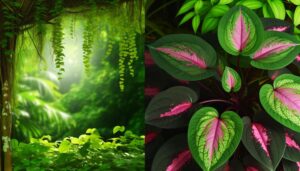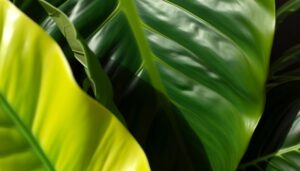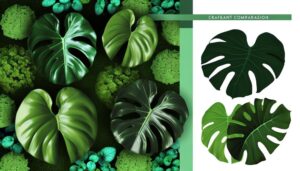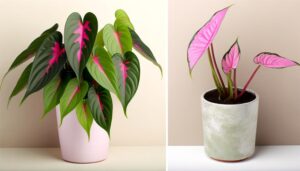Philodendron Green Princess Vs Birkin: Which One Better!
Philodendron Green Princess and Birkin both hail from the tropical rainforests of Central and South America, exhibiting epiphytic growth habits. Green Princess features deep green ovate leaves, larger in size (15-25 cm), whereas Birkin showcases smaller, variegated elliptic leaves with distinctive white or cream-colored pinstripes.
The Green Princess maintains a compact stature, growing 12-18 inches, while Birkin can reach up to 24 inches. Both require bright, indirect light and thrive in high humidity.
However, Birkin’s variegation may affect its photosynthetic efficiency. For insights into their color variations, propagation techniques, and common pests, a detailed exploration awaits.

Key Takeaways
- Green Princess has deep green ovate leaves, whereas Birkin features variegated leaves with white or cream-colored streaks.
- Green Princess leaves are larger (15-25 cm) compared to Birkin’s (10-20 cm).
- Birkin can grow taller (up to 24 inches) than the more compact Green Princess (12-18 inches).
- Both thrive in bright, indirect light and require high humidity and consistent temperatures.
- Green Princess is uniformly green, while Birkin’s variegation results from genetic mutations affecting chlorophyll production.
Philodendron Green Princess vs Birkin: Key Differences
| No. | Feature | Philodendron Green Princess | Philodendron Birkin |
|---|---|---|---|
| 1 | Leaf Color | Solid deep green | Variegated with cream or white stripes |
| 2 | Growth Rate | Moderate | Slow to moderate |
| 3 | Price Range (USD) | $20 – $50 | $30 – $80 |
| 4 | Size (Mature Height) | Up to 1 meter | Up to 0.6 meters |
| 5 | Availability | Common | Relatively common |
| 6 | Watering Needs | Moderate | Moderate |
| 7 | Light Requirements | Bright, indirect light | Bright, indirect light |
| 8 | Care Difficulty | Easy to moderate | Easy |
Origins
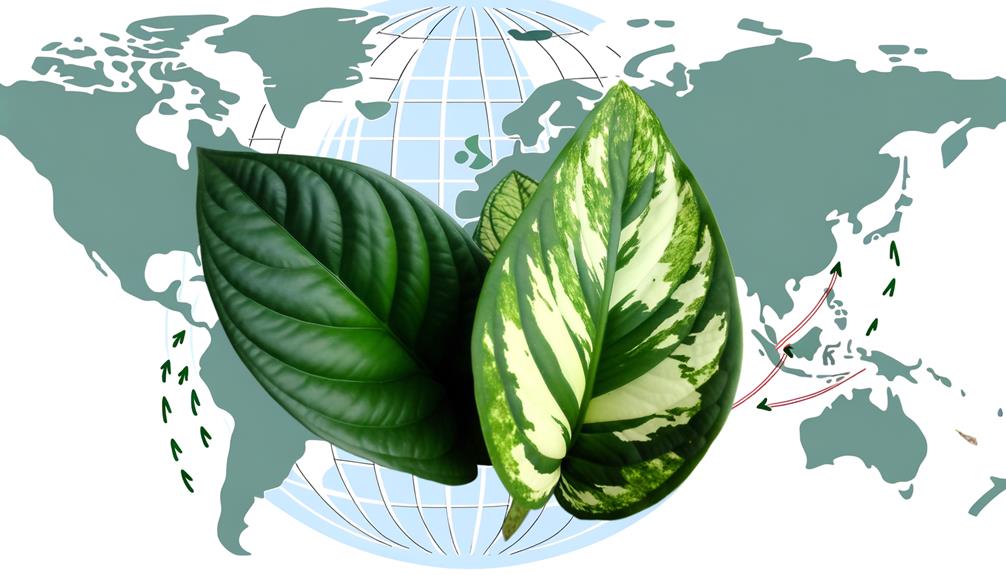
The Philodendron Green Princess and Birkin both originate from the diverse and ecologically rich tropical rainforests of Central and South America. These rainforests provide a unique microclimate characterized by high humidity, consistent temperatures, and indirect sunlight, essential for their growth.
The Green Princess, a cultivar of Philodendron erubescens, and the Birkin, a mutation of Philodendron Rojo Congo, have adapted to these conditions, exhibiting significant epiphytic tendencies. Such adaptations allow them to thrive on tree trunks and in nutrient-rich leaf litter.
Their development in these habitats has led to their popularization as ornamental plants due to their robust growth and resilience under indoor conditions, making them suitable for modern horticultural practices and indoor gardening enthusiasts.
Leaf Shape
The leaf morphology of Philodendron Green Princess and Birkin exhibits distinctive characteristics that merit detailed comparison. Both species present unique leaf patterns, variations in shape, and size, and differing growth habits.
This section will methodically examine the specific attributes that differentiate their foliage, providing a thorough understanding of their botanical distinctions.
Unique Leaf Patterns
Distinctive leaf morphology characterizes both Philodendron Green Princess and Birkin, with each variety exhibiting unique patterns that are essential for accurate botanical identification.
Philodendron Green Princess displays uniformly deep green leaves devoid of variegation, providing a consistent, glossy appearance.
In contrast, Philodendron Birkin showcases a striking variegation pattern, with white or cream-colored pinstripes radiating from the central vein, creating a visually complex and attractive foliar display.
The variegation in Birkin is not symmetrical, adding to its ornamental appeal, while Green Princess’s uniformity suggests stability in its chlorophyll distribution.
These morphological differences are critical for horticulturists and botanists for precise classification and care, underscoring the importance of detailed observation in the study of Philodendron species.
Shape and Size
Leaf morphology in Philodendron Green Princess and Birkin reveals significant differences in shape and size, contributing to their distinct botanical profiles.
The Green Princess features ovate leaves with a uniform, glossy texture and a consistent green hue.
In contrast, Birkin showcases elliptic leaves characterized by their variegated patterns, often streaked with white or light green lines.
The leaf size is typically larger in Green Princess, ranging from 15-25 cm in length, whereas Birkin’s leaves are more modest, averaging between 10-20 cm.
| Attribute | Green Princess | Birkin |
|---|---|---|
| Leaf Shape | Ovate | Elliptic |
| Leaf Texture | Glossy, uniform | Variegated with streaks |
| Leaf Size | 15-25 cm | 10-20 cm |
This morphological divergence underscores their unique aesthetic and functional traits.
Growth Habits
Examining the growth habits of Philodendron Green Princess and Birkin reveals how their leaf morphology influences their overall development and adaptability to various environments.
The Philodendron Green Princess exhibits ovate, glossy leaves with a deep green hue, promoting efficient light absorption and transpiration processes conducive to robust growth.
In contrast, the Birkin displays elliptical leaves adorned with striking white variegation. This variegation, while visually appealing, reduces chlorophyll concentration and consequently, photosynthetic efficacy.
The Green Princess’s uniform leaf structure allows for a more consistent energy production, thereby supporting vigorous growth even under suboptimal light conditions.
Meanwhile, the Birkin’s variegated leaves necessitate more precise light management to sustain its unique foliage patterns and overall health.
Both species display adaptive versatility, catering to diverse horticultural preferences.
Color Variations

The ‘Philodendron Green Princess‘ exhibits a consistent dark green pigmentation, whereas the ‘Birkin‘ is characterized by distinctive variegation patterns featuring white or cream-colored streaks against a green background.
These variegation patterns in ‘Birkin’ result from a genetic mutation, leading to an unpredictable and unique leaf appearance in each specimen. Moreover, the degree of variegation in ‘Birkin’ can vary notably, providing a wide spectrum of aesthetic appeal within the same species.
Leaf Color Differences
Distinctive chromatic variations characterize Philodendron Green Princess and Philodendron Birkin, providing a vivid means to differentiate between these two popular houseplants.
The Philodendron Green Princess exhibits a uniform dark green hue, indicative of its stable chlorophyll concentration across the foliar surface.
Conversely, Philodendron Birkin is renowned for its striking lighter green coloration, interspersed with creamy white streaks, which can be attributed to differential chloroplast distribution and varying chlorophyll levels.
These chromatic distinctions are not merely aesthetic; they reflect underlying physiological differences that influence photosynthetic efficiency and light absorption.
Hence, the contrasting leaf coloration serves as an essential phenotypic marker for horticulturists and plant enthusiasts, facilitating accurate identification and appreciation of each plant’s unique attributes.
Variegation Patterns
In addition to overall leaf color, the variegation patterns observed in Philodendron Green Princess and Philodendron Birkin offer a further dimension of differentiation.
Philodendron Birkin displays a more pronounced and intricate array of creamy white streaks set against its green backdrop.
The variegation in Philodendron Birkin is characterized by longitudinal, pinstripe-like patterns, which can vary significantly in intensity and distribution.
Conversely, Philodendron Green Princess exhibits minimal variegation, typically limited to subtle, diffuse light green patches that blend seamlessly with the dominant green hue.
This distinct variegation pattern in Philodendron Birkin is attributed to genetic mutations affecting chlorophyll production, resulting in the striking contrast that defines its aesthetic appeal.
Such variegation patterns are critical for enthusiasts seeking visually diverse foliage.
Size and Growth
Philodendron Green Princess typically shows a more compact growth habit compared to the taller and more upright stature of Philodendron Birkin.
The Green Princess, with its dense, bushy form, generally reaches a height of approximately 12-18 inches, making it ideal for limited space environments.
In contrast, Philodendron Birkin can reach heights up to 24 inches, characterized by elongated petioles and a more pronounced vertical growth trajectory.
The Birkin’s expansive leaf structure further accentuates its upward growth, distinguishing it from the more restrained Green Princess.
Both species display moderate growth rates under ideal conditions, yet their morphological differences require distinct spatial planning.
Understanding these size and growth dynamics is essential for effective cultivation and aesthetic arrangement in interior plant scaping.
Light Requirements
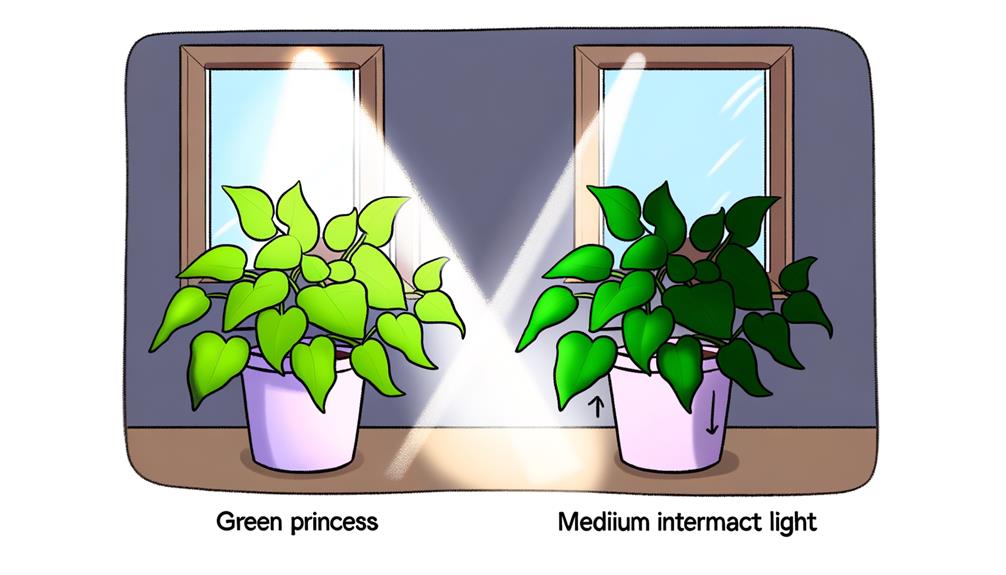
Ideal light conditions for Philodendron Green Princess and Birkin involve bright, indirect light to encourage healthy growth and prevent leaf discoloration or scorching.
Both species thrive in environments where they receive filtered sunlight or artificial lighting that mimics natural light. Direct sunlight may lead to leaf burn, while insufficient light can cause leggy growth and diminished variegation.
| Aspect | Philodendron Green Princess | Birkin |
|---|---|---|
| Best Light Level | Bright, indirect | Bright, indirect |
| Tolerance to Low Light | Moderate | Moderate |
| Risk of Direct Sunlight | High (leaf burn) | High (leaf scorch) |
Providing consistent lighting conditions guarantees that both plants maintain their aesthetic appeal and physiological health. Using sheer curtains or placing the plants near north or east-facing windows can optimize light exposure.
Watering Needs
Ensuring ideal hydration for both the Green Princess and Birkin requires a careful balance to prevent common issues such as root rot or drought stress.
Both species necessitate a well-regulated watering schedule, typically requiring water when the top 2-3 inches of soil are dry to the touch. Overwatering can lead to anaerobic conditions detrimental to root health, whereas underwatering can cause wilting and nutrient uptake inefficiencies.
Employing a moisture meter can be advantageous for precise monitoring. The use of tepid, dechlorinated water is best to minimize potential stress from temperature shock or chloramine toxicity.
Consistent observation and adjustment, depending on seasonal variations and ambient humidity, are imperative for maintaining the physiological equilibrium of these philodendrons.
Soil Preferences
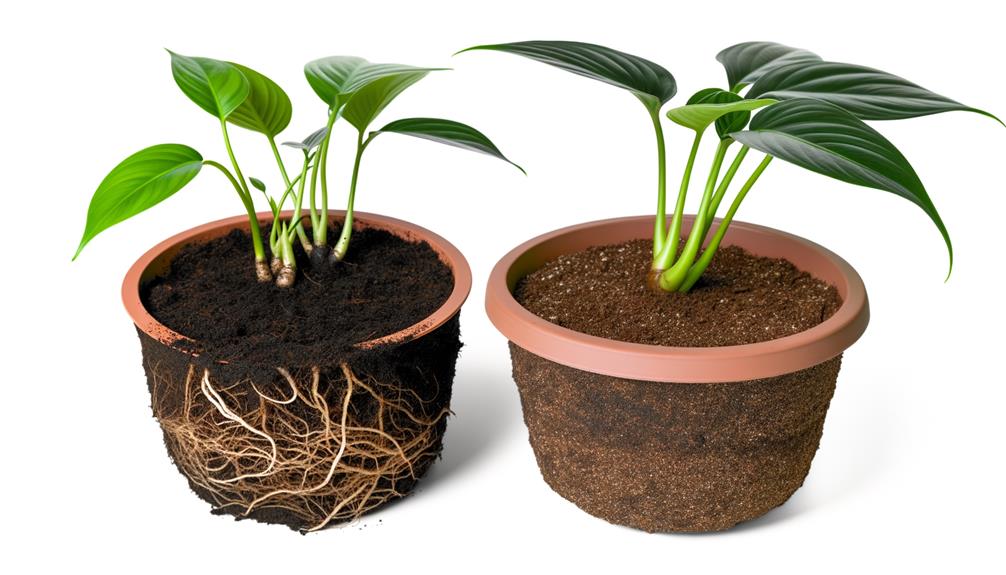
Both Philodendron Green Princess and Birkin have specific soil requirements that greatly impact their growth and overall health. Essential factors to keep in mind include the ideal pH levels, which should be slightly acidic to neutral.
Best drainage characteristics are crucial to prevent root rot, and the appropriate nutrient composition is necessary to support their metabolic needs.
A systematic examination of these parameters will clarify the best soil conditions for each species.
Ideal Ph Levels
Although both the Philodendron Green Princess and Birkin thrive in slightly acidic to neutral soil, the best pH range for their growth is typically between 6.0 and 7.0. Maintaining this pH range promotes nutrient availability and uptake. Deviations outside this range could potentially hinder growth, leading to symptoms such as chlorosis or stunted development.
To assist in monitoring pH levels, consider the following table:
| Plant | Optimum pH Range |
|---|---|
| Philodendron Green Princess | 6.0 – 7.0 |
| Philodendron Birkin | 6.0 – 7.0 |
| Symptoms of Low pH | Yellowing Leaves |
| Symptoms of High pH | Stunted Growth |
Regular soil testing is recommended to maintain the ideal pH, ensuring the Philodendron’s health and vitality.
Drainage Requirements
Proper drainage is paramount for both the Philodendron Green Princess and Birkin, as waterlogged conditions can lead to root rot and other detrimental effects on plant health.
Both species thrive in well-aerated, fast-draining soil that mimics their native tropical environments. The ideal soil mix should balance moisture retention with adequate drainage capabilities.
- Soil Composition: Incorporate perlite, orchid bark, and peat moss to enhance drainage and aeration.
- Pot Selection: Utilize pots with drainage holes to prevent water accumulation at the base.
- Watering Technique: Employ a soak-and-dry method, ensuring that water drains completely after each watering.
- Soil pH: Maintain a slightly acidic to neutral pH, which facilitates nutrient uptake and overall plant health.
Nutrient Needs
The nutrient needs of the Philodendron Green Princess and Birkin are met by a well-balanced soil composition rich in organic matter and essential minerals. A soil mixture that includes components such as peat moss, perlite, and pine bark offers ideal conditions for root aeration, moisture retention, and nutrient availability.
Organic matter, decomposed into humus, releases essential macro and micronutrients like nitrogen, phosphorus, and potassium, which are essential for robust growth and foliage development. The addition of slow-release fertilizers can further enhance nutrient supply, ensuring sustained plant health.
Regular monitoring of soil pH, ideally maintained between 5.5 and 6.5, is important to prevent nutrient lockout and facilitate effective nutrient uptake, thereby supporting the physiological needs of both Philodendron varieties.
Temperature Tolerance
Temperature tolerance in Philodendron Green Princess and Birkin is a critical factor influencing their growth and overall health. Both species thrive within specific temperature ranges, and deviations can lead to physiological stress or deterioration.
The ideal temperature range for these philodendrons is between 65°F and 80°F. Exceeding these temperatures can hinder photosynthesis and metabolic functions, while temperatures below 55°F can cause cellular damage.
Understanding these parameters guarantees that environmental conditions are meticulously controlled, promoting robust development and minimizing stress-induced pathologies in Philodendron Green Princess and Birkin.
- Optimal temperature: 65°F to 80°F
- Cold tolerance threshold: Minimum 55°F
- Heat stress: Above 85°F can lead to stomatal closure
- Temperature fluctuation: Stable temperatures preferred for consistent growth
Humidity Levels
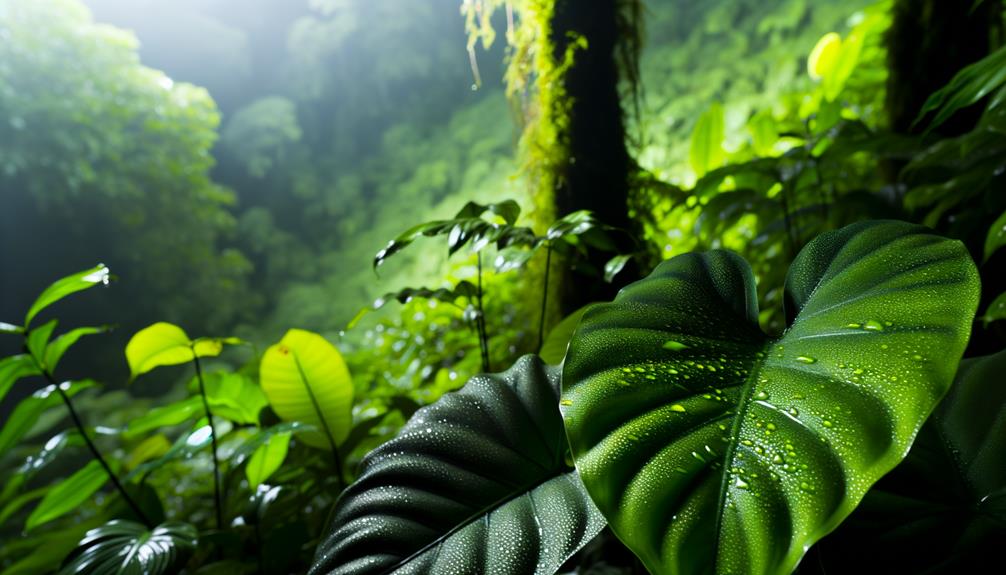
Maintaining humidity levels between 60% and 80% is essential for the best growth and physiological functions of both Philodendron Green Princess and Birkin. These tropical species exhibit peak cellular activities, including photosynthesis and transpiration, within this humidity range.
Inadequate humidity can lead to desiccation of foliar tissues, causing leaf curling and marginal browning. Conversely, excessive humidity may promote fungal pathogens due to prolonged leaf wetness. Employing methods such as frequent misting, using humidity trays, or integrating a humidifier can sustain the necessary microenvironment.
Regular monitoring with a hygrometer ensures accurate humidity control. Therefore, managing ambient moisture levels meticulously contributes to the overall health and aesthetic appeal of both plant varieties, fostering robust growth and vibrant foliage.
Propagation Methods
Ensuring perfect moisture levels sets the stage for successful propagation methods when cultivating Philodendron Green Princess and Birkin.
Both species are typically propagated through stem cuttings, which involves selecting a healthy stem with at least one node.
The node is crucial, as it contains the meristematic tissue necessary for root development. The cutting should be placed in water or a well-draining soil mix to initiate root growth.
Key steps in the propagation process include:
- Selection of healthy stem cuttings: Confirm the presence of nodes and leaves.
- Sterilization of cutting tools: Prevent contamination and diseases.
- Ideal environmental conditions: Maintain humidity levels between 60-80%.
- Monitoring root development: Shift cuttings to soil once roots are established.
This methodical approach ensures ideal propagation outcomes.
Common Pests
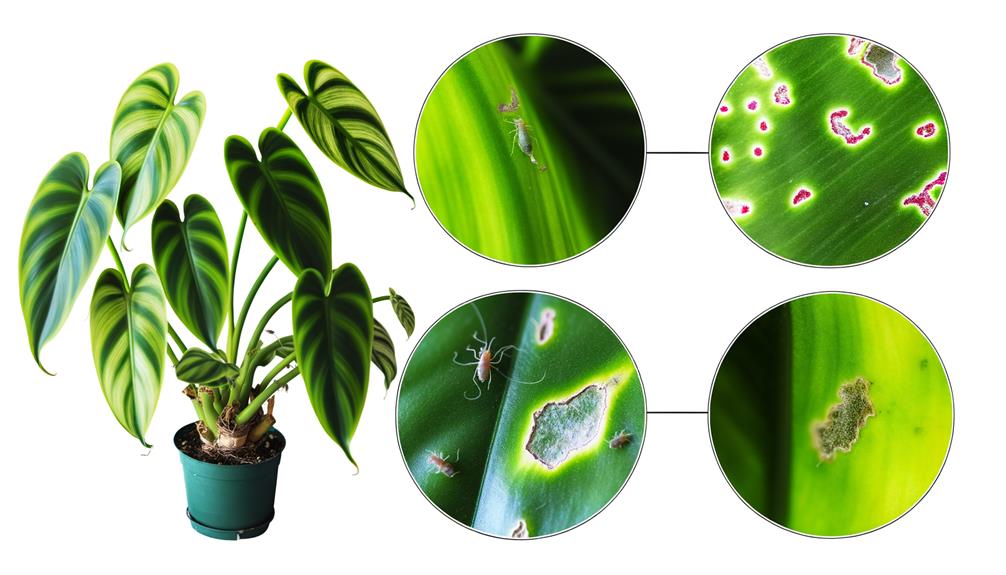
Philodendron Green Princess and Birkin are vulnerable to a variety of common pests, including spider mites, aphids, and mealybugs, which can significantly impact their health and growth.
Spider mites, belonging to the Tetranychidae family, thrive in dry conditions and cause stippling on leaves due to their sap-sucking behavior.
Aphids, from the Aphididae family, excrete honeydew, facilitating sooty mold growth and impairing photosynthesis.
Mealybugs, Pseudococcidae family members, form cotton-like masses on plant surfaces, leading to chlorosis and stunted growth.
Regular inspection and early intervention are essential for pest management. Utilizing insecticidal soap, neem oil, or systemic insecticides can effectively reduce pest populations, promoting the overall vigor and aesthetic appeal of these philodendron varieties.
Popularity and Availability
Both Green Princess and Birkin varieties exhibit substantial popularity in the horticultural market due to their unique foliage characteristics and relative ease of care. The Green Princess, with its compact growth habit and deep green leaves, contrasts strikingly with the Birkin’s distinctive variegated foliage featuring creamy white streaks. Their prevalence is supported by:
- Market Demand: These varieties are highly sought after by both novice and experienced plant enthusiasts.
- Propagation: Both plants are relatively easy to propagate, contributing to their widespread availability.
- Nurseries and Retailers: Numerous nurseries and online retailers frequently stock these varieties due to their popularity.
- Price Point: While generally affordable, rare specimens or mature plants can command higher prices.
This combination of factors ensures their continued prominence in the market.
Conclusion
In the verdant tapestry of Philodendron species, the Green Princess and Birkin stand as distinct yet intertwined threads. Their origins, leaf morphology, chromatic diversity, and cultivation needs form a symbiotic dance of nature and nurture.
While their growth habits and environmental preferences diverge, both manifest resilience against common pests and boast accessible propagation methods.
The allure of these botanical specimens lies in their unique characteristics and widespread availability, ensuring their continued prominence in horticultural collections.

